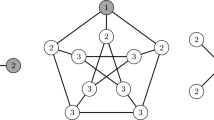Abstract
Graph burning is a graph process modeling the spread of social contagion. Initially all the vertices of a graph G are unburned. At each step an unburned vertex is put on fire and the fire from burned vertices of the previous step spreads to their adjacent unburned vertices. This process continues till all vertices are burned. The burning number b(G) of the graph is the minimum number of steps required to burn all the vertices in the graph. The burning number conjecture by Bonato et al. states that for a connected graph G of order n, its burning number \(b(G) \le \lceil \sqrt{n}~\rceil \). It is easy to observe that in order to burn a graph it is enough to burn its spanning tree. Hence it suffices to prove that for any tree T of order n, its burning number \(b(T) \le \lceil \sqrt{n}~\rceil \). A spider S is a tree with one vertex of degree at least 3 and all other vertices with degree at most 2. Here we prove that for any spider S of order n, its burning number \(b(S) \le \lceil \sqrt{n}~\rceil \).
Access this chapter
Tax calculation will be finalised at checkout
Purchases are for personal use only
Similar content being viewed by others
References
Bonato, A., Janssen, J.C.M., Roshanbin, E.: How to burn a graph. Internet Math. 12(1–2), 85–100 (2016)
Bonato, A., Janssen, J.C.M., Roshanbin, E.: Burning a graph is hard. ArXiv e-prints arXiv:1507.06524 (2015)
Land, M.R., Lu, L.: An upper bound on the burning number of graphs. In: Bonato, A., Graham, F.C., Prałat, P. (eds.) WAW 2016. LNCS, vol. 10088, pp. 1–8. Springer, Cham (2016). https://doi.org/10.1007/978-3-319-49787-7_1
Mitsche, D., Pralat, P., Roshanbin, E.: Burning graphs: a probabilistic perspective. Graph. Comb. 33(2), 449–471 (2017)
Roshanbin, E.: Burning a graph as a model of social contagion. Ph.D. thesis, Dalhousie University (2016)
West, D.B.: Introduction to Graph Theory, 2nd edn. Pearson Education, London (2002)
Acknowledgement
We thank the anonymous reviewers for their valuable comments and suggestions to improve the clarity of the paper.
Author information
Authors and Affiliations
Corresponding author
Editor information
Editors and Affiliations
Rights and permissions
Copyright information
© 2018 Springer International Publishing AG
About this paper
Cite this paper
Das, S., Dev, S.R., Sadhukhan, A., Sahoo, U.k., Sen, S. (2018). Burning Spiders. In: Panda, B., Goswami, P. (eds) Algorithms and Discrete Applied Mathematics. CALDAM 2018. Lecture Notes in Computer Science(), vol 10743. Springer, Cham. https://doi.org/10.1007/978-3-319-74180-2_13
Download citation
DOI: https://doi.org/10.1007/978-3-319-74180-2_13
Published:
Publisher Name: Springer, Cham
Print ISBN: 978-3-319-74179-6
Online ISBN: 978-3-319-74180-2
eBook Packages: Computer ScienceComputer Science (R0)




